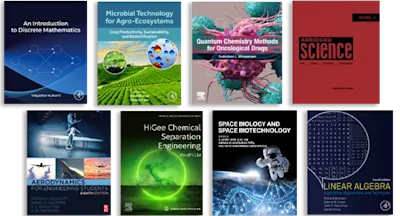
Application of DNA-based Nanomaterials in Tissue Regeneration
- 1st Edition - May 1, 2026
- Latest edition
- Editors: Yunfeng Lin, Taoran Tian, Songhang Li, Yuanlin Tang
- Language: English
Application of DNA-based Nanomaterials in Tissue Regeneration provides a detailed explanation of the mechanisms by which DNA nanomaterials facilitate tissue regeneration, includ… Read more
Purchase options

- Provides a detailed explanation of the mechanism of nucleic acid nanostructure in tissue regeneration
- Covers DNA nanomaterial-based cell surface engineering
- Includes supramolecular DNA hydrogels and DNA nanomaterial based drug delivery system for tissue regeneration
1. Nucleic Acid Nanostructures 1.1 Two-Dimensional Nucleic Acid Nanostructures
1.2 Three-Dimensional Nucleic Acid Nanostructures
2. Cellular Uptake of Nucleic Acid Nanostructures
3. Intracellular Fate of Framework Nucleic Acids
3.1 Intracellular Transport of Framework Nucleic Acids
3.2 Metabolic Degradation of Framework Nucleic Acids
4. In Vivo Delivery of Nucleic Acid Nanomaterials (In Vivo Distribution and Circulation Clearance)
5. The Mechanism of Action of Nucleic Acid Nanomaterials
5.1 Mechanism of Action Based on Three-Dimensional Structure
5.2 Mechanism of Action of Nucleic Acids
Part II: DNA Nanomaterial-Based Cell Surface Engineering for Tissue Regeneration
6. Introduction
6.1 Introduction to Cell Surface Engineering
6.2 Advantages of DNA Nanomaterials as Surface Engineering Materials
7. Cell Surface Engineering Modification Method Based on DNA Nanomaterials
7.1 DNA Molecules Covalently Modify Cell Membranes
7.2 DNA Molecules Non-Covalently Modify Cell Membranes
8. Application of Cell Surface Engineering Methods Based on DNA Nanomaterials in Tissue Regeneration
8.1 Cell Interactions
8.1.1 Cluster Transplant
8.1.2 Direct Cell-to-Cell Adhesion
8.2 Cell Microenvironment Communication
8.2.1 Real-Time Monitoring
8.2.2 Signal Path Control
8.2.3 Mechanism Explanation
8.3 Treating the Cells Themselves
8.3.1 Direct Deposition of Protective Materials on Cell Surface
8.3.2 Cell-Mediated Drug Delivery
9. Challenges and Prospects of DNA Nanomaterials in Cell Surface Engineering
9.1 Prospection
9.2 Challenges
Part III: Supramolecular DNA Hydrogels for Tissue Regeneration: Current Application and Future Development
10. Introduction
11. The Advantages of DNA Hydrogel in Tissue Regeneration
11.1 Biocompatibility
11.2 Editability
11.2.1 Accurate Structural Control
11.2.2 Easy to Functionalize
11.2.3 Stimulus Responsiveness
11.3 Adjustable Mechanics
11.4 Relative Stability
12. The Design and Strategy of DNA Hydrogel
12.1 Pure DNA Hydrogel
12.1.1 Based on Sticky Ends
12.1.2 Based on Rolling Ring Amplification (RCA)
12.2 Hybrid DNA Hydrogel
12.2.1 Chemical Cross-Linking
12.2.2 Physical Cross-Linking
13. The Supramolecular DNA Hydrogels for Different Tissue Regeneration Fields
13.1 Skin Regeneration
13.2 Bone Regeneration
13.3 Cartilage Regeneration
13.4 Neural Regeneration
14. Prospects and Challenges
Part IV: DNA Nanomaterial-Based Drug Delivery System: Application in Tissue Regeneration
15. Drug Loading Strategy
15.1 Electrostatic Adsorption
15.2 Physical Chimerization
15.3 Covalent Modification
15.4 Non-Covalent Modification
15.5 Sequence Extension
15.6 Sticky Ends
16.Application of Delivery Modification Based on DNA Nanomaterials in Tissue Regeneration
16.1 Physical-Chemical Modification - Modification Method: Polymer Modification, Metal Ions, Visible Light and pH Value, etc. - Functional Purpose: Controlled Drug Release - Drug Application: Tissue Regeneration
16.2 Biological Modification - Basis of Modification: DNA Nanomaterials - Modification Method: Cell Membrane, Exosomes, and Apoptotic Vesicles, etc. - Functional Purpose: Drug Targeting - Drug Application: Tissue Regeneration
16.3 Multiple Modifications - Modification Method: Physical-Chemical Modification + Biological Modification - Functional Purpose: Drug Controlled Release/Targeting - Drug Application: Tissue Regeneration
- Edition: 1
- Latest edition
- Published: May 1, 2026
- Language: English
YL
Yunfeng Lin
Yunfeng Lin is Vice Dean of West China College of Stomatology, and Vice-director of State Key Laboratory of Oral Diseases. His main research focuses on DNA Nanomaterial, Stem Cell Biology and Tissue Regeneration. He’s published over 234 SCI papers including Nature Protocols, Advanced Materials, Materials Today, Nano Today, Advanced Functional Materials, ACS Nano, Nano Letters, Nano Micro Letters, Journal of Dental Research et al. Dr. Lin has edit 8 English books. He’s received many awards, including IADR Distinguished Scientist Isaac Schour Memorial Award, Yangtze River Scholar Distinguished Professor, National High-level personnel of special support program of China, and Young Scientific and Technological Innovation Leader of China, to name a few. Additionally, he is the Executive Editor in Chief of Bone Research and Cell Proliferation, Editor of International Journal of Dental Research, Journal of Dental Research.
TT
Taoran Tian
Taoran Tian is an Associate Professor in the Department of Oral Implantology at West China Hospital of Stomatology and a Master's supervisor. He pursued joint doctoral training at Yale University in the United States. Dr. Tian was selected for the Sichuan Provincial "Health and Wellness Talent Plan" as a young and middle-aged key talent. He has been awarded the Chinese Medical Science and Technology Award for Young Scientists and serves as a youth member of the Sichuan Medical Association's Stomatology Committee.
SL
Songhang Li
YT
Yuanlin Tang
Yuanlin Tang, assistant researcher of Sichuan University, is engaged in nucleic acid nanomaterials research in the State Key Laboratory of Oral Disease Prevention and Treatment. She is the deputy secretary of the General of Medical and Media mutual Promotion Branch of Sichuan Medical Science and Technology Innovation Research Association, and the member of the Oral Materials Professional Committee of Sichuan Stomatological Society. Her research interests include nucleic acid nanomaterials, health policy & management, medical media,etc.